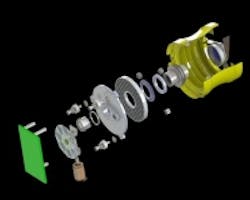NASA engineer developing 3D printed space cameras
NASA aerospace engineer Jason Budinoff is developing a set of imaging telescopes assembled almost entirely from 3D printed components that are expected to be ready by the end of September.
Funded by NASA’s Goddard Space Flight Center in Greenbelt, Maryland, Budinoff’s project involves the construction of a 50 mm (2 in.)camera with an outer tube, baffles, and optical mounts all printed as a single structure. The 3D printed camera is appropriately sized for a CubeSat, which is a tiny satellite made up of individual units each about four inches on a side. The instrument will be equipped with conventionally fabricated mirrors and glass lenses and will undergo vibration and thermal vacuum testing in 2015.
The goal of this project, according to Budinoff, is to act as a pathfinder in the sense that the traditional building of telescopes involves hundreds of pieces, but with 3D printing, the process can be made easier. With 3D printing, said Budinoff, “we can reduce the overall number of parts and make them with nearly arbitrary geometries. We’re not limited by traditional mill- and lathe-fabrication operations.”
Specifically, a 3D printed 2- in. camera design involves the fabrication of four different pieces made from powdered aluminum and titanium, but atraditionally-manufactured camera would require between five and 10 times the number of parts. In addition, 3D printing these cameras will significantly reduce the overall cost, according to the NASA press release.
Furthermore, Budinoff has his sights set on using 3D printing and powdered aluminum for developing telescope mirrors as well as experimenting with printing instrument components made of Invar alloy, a material being prepared for 3D printing by Goddard technologist Tim Stephenson. Budinoff is also assembling a 14 in. dual-channel telescope with 3D printing.
“Anyone who builds optical instruments will benefit from what we’re learning here,” Budinoff said. “I think we can demonstrate an order-of-magnitude reduction in cost and time with 3D printing.”
View thepress release.
Share your vision-related news by contactingJames Carroll, Senior Web Editor, Vision Systems Design
To receive news like this in your inbox,click here.
Join ourLinkedIn group | Like us on Facebook | Follow us on Twitter| Check us out on Google +
About the Author

James Carroll
Former VSD Editor James Carroll joined the team 2013. Carroll covered machine vision and imaging from numerous angles, including application stories, industry news, market updates, and new products. In addition to writing and editing articles, Carroll managed the Innovators Awards program and webcasts.
